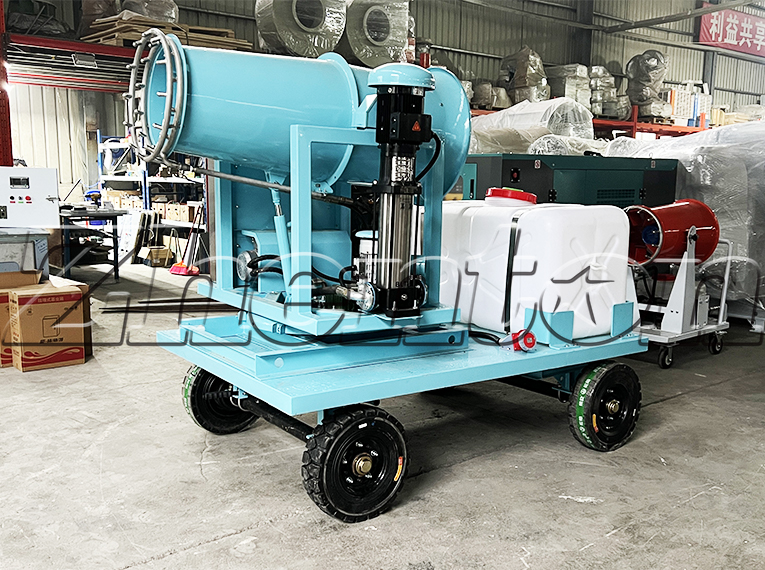
Guided by the “dual carbon” goals (carbon peaking and carbon neutrality), various environmental protection equipment has been making efforts, and the fog cannon, a “veteran in dust suppression“, is taking on a new role as a key player in the carbon reduction campaign. Currently, the game between China and the United States in the field of carbon emissions continues to heat up. The United States is promoting unilateral carbon tariff policies such as the Foreign Pollution Fee Act, linking carbon emissions to trade access, while China adheres to the principle of “common but differentiated responsibilities” and takes practical actions to address green trade barriers. Against this backdrop, the fog cannon not only protects clean air through high-pressure atomization technology but also plays an indispensable role in implicit carbon reduction, injecting green momentum into industrial production and urban governance.
The core logic of the fog cannon’s carbon reduction lies in “dust suppression equals carbon reduction”. Dust generated in industrial production and construction not only pollutes the air but also indirectly increases carbon emissions. Traditional dust suppression mostly relies on water sprinklers for extensive watering, which wastes a large amount of water resources, and additional energy is required for subsequent sewage treatment. In contrast, the fog cannon atomizes water into micron-sized particles through a high-pressure pump, accurately covering the source of dust. It can not only quickly settle dust but also save more than 80% of water resources. The efficient use of water resources reduces energy consumption in sewage treatment and water extraction, thereby cutting down indirect carbon emissions. At the same time, the effective control of dust avoids extra energy consumption caused by air pollution treatment, forming a positive cycle of “dust suppression – water conservation – carbon reduction”.

In industrial scenarios, the fog cannon has become a “capable assistant” for enterprises in carbon reduction. Industries such as iron and steel and cement are key areas under the carbon tariff control of Europe and the United States. In the past, these heavily polluting sites required significant energy input for exhaust gas treatment due to dust problems. Nowadays, fixed fog cannons can accurately cover production workshops and raw material yards, while mobile fog cannons move flexibly on factory roads for 24-hour continuous dust suppression. After a mining enterprise introduced fog cannons, the concentration of dust emissions dropped by 70%, and the annual indirect carbon emissions were reduced by more than 500 tons due to water conservation and reduced energy consumption for pollution treatment. This not only achieves a win-win situation for environmental protection and economic benefits but also provides a practical path for addressing cross-border carbon cost accounting.
In urban governance, the fog cannon is also a “light cavalry” for carbon reduction. In scenarios such as road cleaning, demolition sites, and garbage landfills, regular operation of vehicle-mounted and tower-type fog cannons effectively curbs urban dust. Compared with traditional water sprinklers, the atomized water from fog cannons combines with dust more easily, increasing dust suppression efficiency by more than 3 times, and avoiding increased traffic energy consumption caused by road water accumulation. During hot summer days, fog cannons can also improve the urban microclimate by cooling and humidifying, reducing carbon emissions from air conditioning use, and serving as a multi-functional equipment for urban green transformation.

From industrial parks to urban streets, the fog cannon, a “small equipment”, plays a “big role” and empowers carbon reduction practices with technology. Amid the intensifying competition between China and the United States in green technology and trade rules, the popularization of such practical carbon reduction technologies is not only a choice for enterprises to reduce their carbon footprint and avoid carbon tariff risks but also a reflection of China’s participation in global climate governance through concrete actions. With technological upgrading, intelligent fog cannons can achieve precise dust control and on-demand operation through the Internet of Things, further reducing energy consumption. As China steadily advances on the path of “dual carbon”, the fog cannon, with its unique carbon reduction effect, is becoming an important force in safeguarding blue skies and promoting sustainable development.
Contact With Us
If you have any questions please fell free to contact with us.